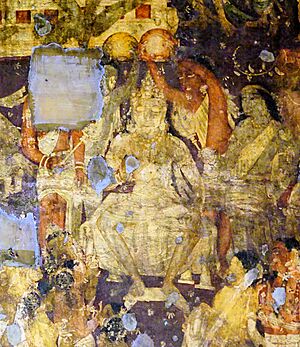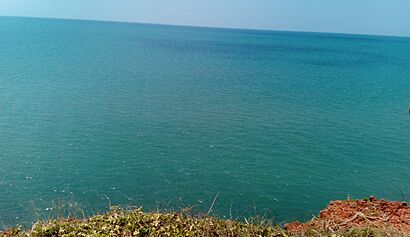Prince Vijaya facts for kids
Quick facts for kids Vijaya |
|
|---|---|

Coronation of Prince Vijaya; detail from the Ajanta Caves mural of Cave 17
|
|
| Reign | c. 543 – c. 505 BCE |
| Successor | Upatissa |
| Born | Sinhapura |
| Died | 505 BC Tambapanni |
| Wives |
|
| Issue |
|
| Dynasty | House of Vijaya |
| Father | Sinhabahu |
| Mother | Sinhasivali |
Prince Vijaya (around 543–505 BCE) was a famous king of Tambapanni. This kingdom was in what is now Sri Lanka. His story first appeared in an ancient book called Mahāvaṃsa.
The legend says that Prince Vijaya came to Sri Lanka with 700 followers. He had been sent away from his home, Sinhapura. However, there is no old evidence from digs (archaeology) to prove this story.
When they arrived, Vijaya and his group defeated a group of people called yakshas. This happened near a place called "Thammena" (Tambapaṇṇī). Later, Vijaya married Kuveni, who was the daughter of a yaksha leader. This marriage helped Vijaya become the rightful ruler of the area.
Contents
Stories About Prince Vijaya
There are four main stories about how the Sinhalese people began. In all these stories, a prince comes to the island of Lanka. He then starts a community that grows into the Sinhalese people. Two stories call the prince Vijaya. The other two use different names for him.
The Mahavamsa Story
In the Mahavamsa story, Vijaya's grandmother was a princess. Her family came from the Vanga and Kalinga kingdoms. These are in modern-day Bengal and Odisha, India. She had two children with a "lion" (Sinha). He kept them trapped in a forest.
The princess and her children escaped. Her son, Sinhabahu, later killed Sinha. Prince Vijaya was Sinhabahu's son. Vijaya started the kingdom of Sinhapura. He became the prince-regent, like a co-ruler. But he was sent away with 700 followers to Lanka because of his bad actions.
The Mahavamsa story has a small puzzle. It says the Buddha had already sent all the yakkhas away to another island. But Vijaya still met yakshas on Lanka. A female yakkha, Kuveni, even became his queen. Kuveni helped Vijaya defeat the yaksha city of Sirisavatthu. They had two children together.
But to be a true king, Vijaya needed to marry a princess from a noble family. So, he married the daughter of a Pandu king from South India. This king also sent other women to be wives for Vijaya's followers.
Kuveni and her two children left for the yakkha city of Lankapura. There, other yakkhas killed her for helping Vijaya. Vijaya died without any other children. His nephew, Panduvasudeva, came from India. He took over Vijaya's kingdom. The community Vijaya started became the Sinhalese people.
The Valahassa Jataka Story
This story is from the Jataka tales. It is even shown in paintings in the Ajanta cave paintings in India. Here, the prince is a merchant named Sinhala. He is the son of Sinha.
Sinhala and 500 followers sailed to Ratnadeepa (Lanka). They hoped to find gems there. Their ship crashed, but female spirits called Yakkhinis saved them. These Yakkhinis pretended to be widows of other merchants. Sinhala married their leader. But he soon found out they were dangerous spirits.
Sinhala and 250 of his men escaped on a flying horse. The Yakkhini leader followed them to his father's kingdom. She tricked his father, Simha, and then ate him and most of his family. Only Sinhala survived. She then went back to Ratnadeepa and ate the rest of Sinhala's followers.
Sinhala became king. He led an army back to Ratnadeepa. He defeated the Yakkhinis and started the Sinhalese kingdom.
Prince Vijaya Arrives in Sri Lanka

Vijaya was made a prince-regent by his father. But he and his followers became known for their violent acts. People complained many times, but Vijaya did not stop. So, important citizens asked that Vijaya be put to death.
King Sinhabahu then sent Vijaya and his 700 followers away from the kingdom. Their heads were partly shaved. They were put on a ship that sailed out to sea. The wives and children of these men were sent on different ships.
Vijaya and his followers landed at a place called Supparaka. The women landed at Mahiladipaka. The children landed at Naggadipa. Vijaya's ship later reached Lanka. This was in the area known as Tambapanni. This happened on the same day that Gautama Buddha died in northern India.
Some people think Vijaya started from the west coast of India. They believe Supparaka is modern-day Sopara. Others think Sinhapura was in eastern India. They suggest Supparaka might have been Sumatra.
According to the Mahavamsa, the Buddha asked the lord of gods (Indra) to protect Vijaya. This was so Buddhism could grow in Lanka. Indra gave the job of protecting Lanka to a god called Upulvan. This god came to Lanka disguised as a holy man to protect Vijaya.
Vijaya tied a special protective thread (a paritta) on his followers' hands. Later, a Yakkhini appeared as a dog. One follower thought a dog meant people lived nearby. He followed her. He then saw a Yakkhini named Kuveni (or Kuvanna) making thread.
Kuveni tried to eat him. But Vijaya's magic thread protected him. She could not kill him. So, Kuveni threw him into a deep hole. She did the same to all 700 followers. Vijaya went to Kuveni's place looking for his men. He defeated her and made her free them.
Kuveni asked Vijaya to spare her life. She promised to be loyal to him. She brought food and goods from the ships of traders she had eaten. Vijaya took her as his partner.
Starting the Tambapanni Kingdom
Vijaya woke up to the sounds of music and singing. Kuveni told him that the island was home to Yakkhas. She said they would kill her for helping Vijaya's men. The sound was from a wedding in the Yakkha city of Sirisavatthu.
With Kuveni's help, Vijaya defeated the Yakkhas. Vijaya and Kuveni had two children: Jivahatta and Disala. Vijaya started a kingdom. It was named Tambapanni. This name means "copper-red hands." This was because the men's hands turned red from the area's red soil. People in Vijaya's group were called Sinhala, after Sinhabahu.
Vijaya's ministers and followers started several villages. Upatissa started Upatissagāma. This was on the Gambhira river, north of Anuradhagama. Vijaya's followers decided to make him king. But for this, he needed a noble princess as his queen.
His ministers sent gifts to the city of Madhura. A Pandya king ruled there. (Madhura is thought to be Madurai in Tamil Nadu, India). The king agreed to send his daughter to be Vijaya's bride. He also asked other families to offer their daughters for Vijaya's followers. Many families volunteered.
The king rewarded them. He sent 100 noble young women. He also sent craftsmen, 1,000 families from 18 different guilds (groups of skilled workers), elephants, horses, wagons, and other gifts. This group landed in Lanka at a port called Mahatittha.
Vijaya then asked Kuveni, his Yakkhini partner, to leave. His people were afraid of supernatural beings like her. He offered her money. He asked her to leave their two children behind. But Kuveni took the children with her to the Yakkha city of Lankapura.
She asked her children to wait outside the city. She went inside. Other Yakkhas saw her as a traitor. They thought she was a spy. A Yakkha killed her. Her children's uncle told them to run away to Sumanakuta (now Adam's Peak). In the Malaya region of Lanka, they married. They became the ancestors of the Pulinda people (thought to be the Vedda people).
Vijaya was crowned king. The Pandya king's daughter became his queen. Other women married his followers based on their rank. Vijaya gave gifts to his ministers and his father-in-law. He stopped his bad ways. He ruled Lanka peacefully and fairly.
Vijaya's Final Days
Vijaya had no other children after Kuveni left. When he was old, he worried he would die without an heir. So, he decided to bring his twin brother Sumitta from India. He wanted Sumitta to rule his kingdom.
Vijaya sent a letter to Sumitta. But he died before getting a reply. His ministers from Upatissagāma then ruled the kingdom for one year. They waited for Sumitta's reply.
In Sinhapura, Sumitta had become king. He had three sons. His queen was the daughter of the king of Madda. When Vijaya's messengers arrived, Sumitta was too old to go to Lanka. So, he asked one of his sons to go. Panduvasdeva, his youngest son, volunteered. Panduvasdeva and 32 sons of Sumitta's ministers reached Lanka. He then became the new ruler.
Why Vijaya's Story is Important
In Sri Lanka, the story of Vijaya is often used to explain where the Sinhalese people came from. It is sometimes seen as a true history. Scholars like K. M. de Silva have used it to say that the Sinhalese people came from Indo-Aryan groups. This helps to show them as different from the Dravidian people.
But Tamil writers, like Satchi Ponnambalam, say the story is just a made-up tale. They believe it is used to justify the Sinhalese claims to land in Sri Lanka.
See also
- Tomb of Vijaya
- Sri Lankan place name etymology
- List of Sri Lankan monarchs
- History of Sri Lanka


